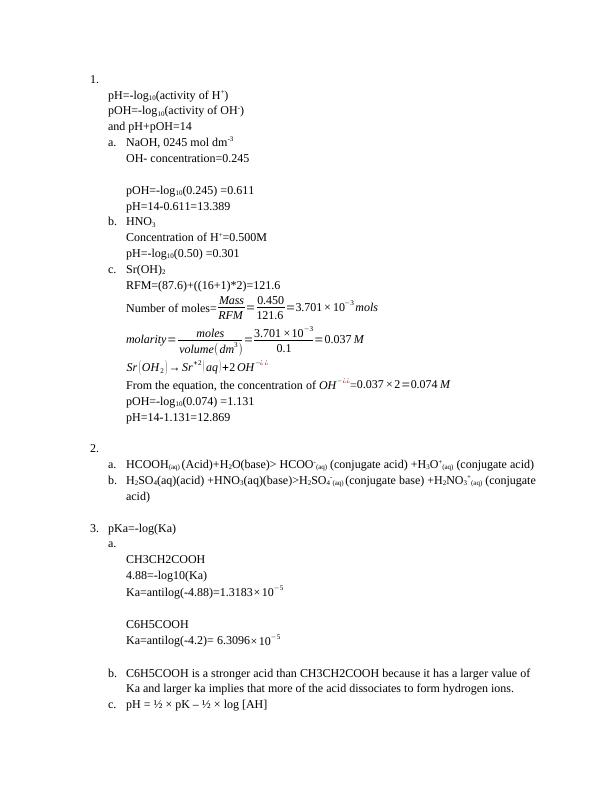Comparison of SN1 and SN2 Mechanisms
Added on 2023-01-09
5 Pages1232 Words75 Views
1.
pH=-log10(activity of H+)
pOH=-log10(activity of OH-)
and pH+pOH=14
a. NaOH, 0245 mol dm-3
OH- concentration=0.245
pOH=-log10(0.245) =0.611
pH=14-0.611=13.389
b. HNO3
Concentration of H+=0.500M
pH=-log10(0.50) =0.301
c. Sr(OH)2
RFM=(87.6)+((16+1)*2)=121.6
Number of moles= Mass
RFM = 0.450
121.6 =3.701× 10−3 mols
molarity= moles
volume(dm3 ) =3.701 ×10−3
0.1 =0.037 M
Sr ( OH 2 ) → Sr+2 ( aq ) +2 OH−¿ ¿
From the equation, the concentration of OH−¿¿=0.037 ×2=0.074 M
pOH=-log10(0.074) =1.131
pH=14-1.131=12.869
2.
a. HCOOH(aq) (Acid)+H2O(base)> HCOO-(aq) (conjugate acid) +H3O+(aq) (conjugate acid)
b. H2SO4(aq)(acid) +HNO3(aq)(base)>H2SO4-(aq) (conjugate base) +H2NO3+(aq) (conjugate
acid)
3. pKa=-log(Ka)
a.
CH3CH2COOH
4.88=-log10(Ka)
Ka=antilog(-4.88)=1.3183×10−5
C6H5COOH
Ka=antilog(-4.2)= 6.3096×10−5
b. C6H5COOH is a stronger acid than CH3CH2COOH because it has a larger value of
Ka and larger ka implies that more of the acid dissociates to form hydrogen ions.
c. pH = ½ × pK – ½ × log [AH]
pH=-log10(activity of H+)
pOH=-log10(activity of OH-)
and pH+pOH=14
a. NaOH, 0245 mol dm-3
OH- concentration=0.245
pOH=-log10(0.245) =0.611
pH=14-0.611=13.389
b. HNO3
Concentration of H+=0.500M
pH=-log10(0.50) =0.301
c. Sr(OH)2
RFM=(87.6)+((16+1)*2)=121.6
Number of moles= Mass
RFM = 0.450
121.6 =3.701× 10−3 mols
molarity= moles
volume(dm3 ) =3.701 ×10−3
0.1 =0.037 M
Sr ( OH 2 ) → Sr+2 ( aq ) +2 OH−¿ ¿
From the equation, the concentration of OH−¿¿=0.037 ×2=0.074 M
pOH=-log10(0.074) =1.131
pH=14-1.131=12.869
2.
a. HCOOH(aq) (Acid)+H2O(base)> HCOO-(aq) (conjugate acid) +H3O+(aq) (conjugate acid)
b. H2SO4(aq)(acid) +HNO3(aq)(base)>H2SO4-(aq) (conjugate base) +H2NO3+(aq) (conjugate
acid)
3. pKa=-log(Ka)
a.
CH3CH2COOH
4.88=-log10(Ka)
Ka=antilog(-4.88)=1.3183×10−5
C6H5COOH
Ka=antilog(-4.2)= 6.3096×10−5
b. C6H5COOH is a stronger acid than CH3CH2COOH because it has a larger value of
Ka and larger ka implies that more of the acid dissociates to form hydrogen ions.
c. pH = ½ × pK – ½ × log [AH]

CH3CH2COOH
pK=-log(1.3183×10−5)=4.88
pH=0.5(4.88)-0.5(log (0.25))=2.741
C6H5COOH
pK=-log(6.3096×10−5)=4.2
pH=0.5(4.2) -0.5(log(0.25))=2.401
4.
Ethanoic acid is a weak acid and its equilibrium is to the left. Addition of CH3COONa
introduces more ethanoate ions in the system. From Le Chatelier’s principle, addition of
more ethanoate ions makes the system to shift equilibrium so as to oppose addition of
more ethanoate ions. The equilibrium thus shifts more to the left. The resulting solution is
made up of un-ionized ethanoic acid, more ethanoate ions from sodium ethanoate and
hydrogen ions.
Buffer action
Adding an acid.
The resulting solution eliminates majority of the new hydrogen ions thus preventing
drastic drop of pH. H+ from acid reacts with ethanoate ions to form ethanoic acid an
although the reaction is reversible, ethanoic acid is a weak acid.
Because majority of H+ are removed in this manner the pH will not vary much
Addition of a base
Two reactions will remove hydroxide ion
1. Reaction with ethanoic acid to form water
2. Reaction with hydrogen ions. There are some H+ ions present in the when ethanoic
acid is ionized. OH- react with them to form water and the process continues until
most of the hydroxide are removed
pK=-log(1.3183×10−5)=4.88
pH=0.5(4.88)-0.5(log (0.25))=2.741
C6H5COOH
pK=-log(6.3096×10−5)=4.2
pH=0.5(4.2) -0.5(log(0.25))=2.401
4.
Ethanoic acid is a weak acid and its equilibrium is to the left. Addition of CH3COONa
introduces more ethanoate ions in the system. From Le Chatelier’s principle, addition of
more ethanoate ions makes the system to shift equilibrium so as to oppose addition of
more ethanoate ions. The equilibrium thus shifts more to the left. The resulting solution is
made up of un-ionized ethanoic acid, more ethanoate ions from sodium ethanoate and
hydrogen ions.
Buffer action
Adding an acid.
The resulting solution eliminates majority of the new hydrogen ions thus preventing
drastic drop of pH. H+ from acid reacts with ethanoate ions to form ethanoic acid an
although the reaction is reversible, ethanoic acid is a weak acid.
Because majority of H+ are removed in this manner the pH will not vary much
Addition of a base
Two reactions will remove hydroxide ion
1. Reaction with ethanoic acid to form water
2. Reaction with hydrogen ions. There are some H+ ions present in the when ethanoic
acid is ionized. OH- react with them to form water and the process continues until
most of the hydroxide are removed

End of preview
Want to access all the pages? Upload your documents or become a member.
Related Documents
Chemistry Study Materiallg...
|10
|2814
|3
